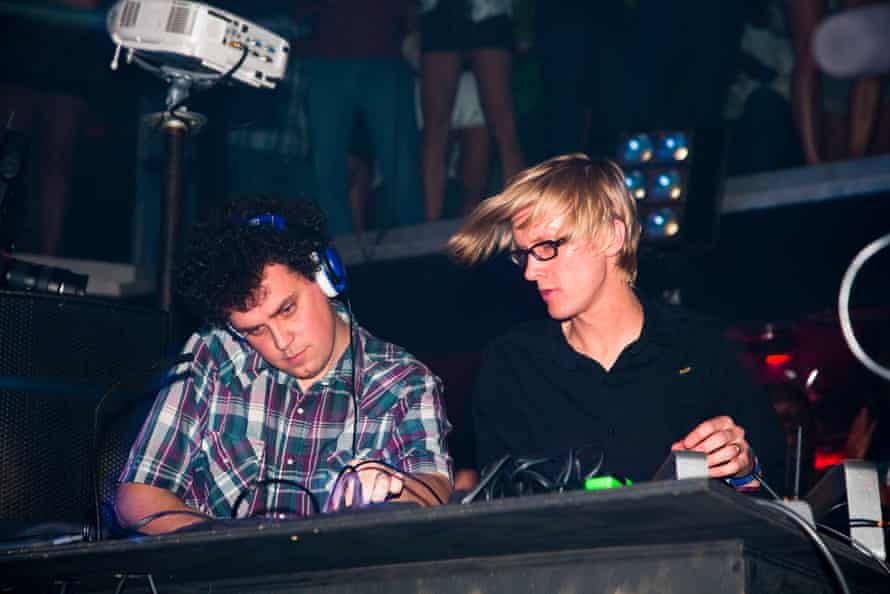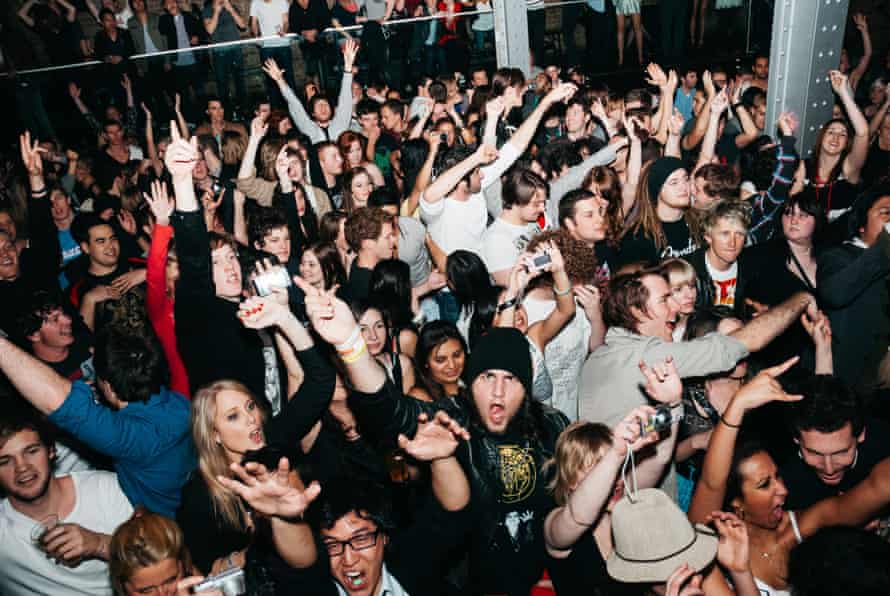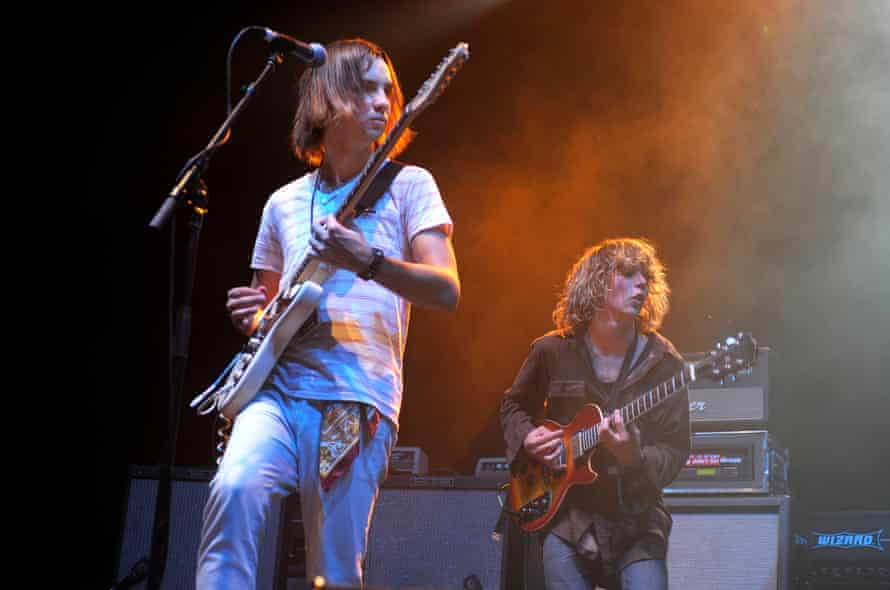In the mid-1990s, a party ruled Sydney’s Kings Cross. It was called Bang Gang, and co-founder Jamie Wirth remembers it well.
“Oh my god, it was wild. It was just chaos, ”remembers Wirth. “There was a bit of twilight, a lot of smooching, it was pretty awesome. It was wild and colorful and it was like everyone was celebrating for their lives. But it was also a celebration of this new form of music: it was exciting and it came out every week. “
The Bang Gang DJs.
This new form of music – a mostly electronic mix of songs released between around 2005 and 2011 by artists such as Justice, Uffie, Simian Mobile Disco, and Erol Alkan – has more recently been referred to as the “bloghouse”. But if you don’t know it by that name, or even what it sounded like, you probably know what it looked like. Bloghouse was also the era of the party celebrity photographer, vice dos and don’ts, American Apparel disco pants, exquisitely decorated MySpace profiles, hipster runoff and Kanye West in shutter sunglasses. If the names Cobra Snake or Cory Kennedy tell you anything, this is probably what you were there for. (And if not, just wait – the aesthetic of this era, dubbed “indie sleaze” by a viral TikTok video, is about to make a comeback.)
 The in-house label of Bang Gang Deejays, Bang Gang 12 Inches. Photo: Bloghouse Artefacts
The in-house label of Bang Gang Deejays, Bang Gang 12 Inches. Photo: Bloghouse Artefacts
What a uniform bloghouse was not a coherent sound, but how you found the music: on music blogs like GottaDanceDirty, Music for Robots and Fluokids. The rise of the home internet meant that inferior MP3s by artists could be distributed in no time, creating an ever-growing treasure trove of new tracks, remixes, and mash-ups. DJs at parties like Bang Gang played the week’s best new releases, but you could just as easily download them to your desktop computer for free. This marked an important micro-revolution for music.
“It was the first time that music got big on the Internet instead of in the club, in the record store or on the radio,” says Lina Abascal, author of the new book Never Be Alone Again: How Bloghouse United the Internet and the Dancefloor, which made this short , but documented transforming moment.
She wanted to explore how the “perfect storm” of change – in technology, the Internet, and the music industry – enabled bloghouse and other cultural changes. Abascal sees Bloghouse – which sonically had “no rules” and just wanted to have fun – as a reaction to the most self-serious iterations of rock and electronic music that preceded it. Carried out largely apart from major labels, by producers who gave their music away for free, and bloggers who wrote about it as a passion project, it wasn’t about monetization. Bloghouse was more than just the songs, explains Abascal; it was “a cultural moment, with music that came out of it”.
 The British electronics duo Simian Mobile Disco will perform in 2009. Photo: PYMCA / Universal Images Group / Getty Images
The British electronics duo Simian Mobile Disco will perform in 2009. Photo: PYMCA / Universal Images Group / Getty Images
Bloghouse was also a boom for Australian artists. The new possibility of selling songs online made it possible to discover local music abroad without the financial support of a large label: Simply upload the track and off you go. “Suddenly the distance between Paris and Sydney or LA and Melbourne was a click,” says Abascal. “That was the first time.”
Australia became a major player in the bloghouse alongside France and the US. Acts like Van She, the Presets, Ladyhawke, Midnight Juggernauts, Pnau, Cut Copy and Bag Raiders found followers overseas and became a tight-knit community (that’s how synonymous with the era that Never Be Alone Again describes the bloghouse sound of bloghouse as “Almost every group of three to four Australians with a V-neck and a synth keyboard”). A healthy nightlife at the time also helped: Van She, for example, met at Bang Gang and got a contract after Stephen Pavlovic, founder of Modular Recordings, saw her play there.
 Julian Hamilton of the Presets will perform at the Enmore Theater in Sydney in 2008. Photo: Mark Metcalfe / Getty Images
Julian Hamilton of the Presets will perform at the Enmore Theater in Sydney in 2008. Photo: Mark Metcalfe / Getty Images
Modular led the scene on site and even recruited a young Tame Impala in 2008 to call you a beer? ‘ Because they didn’t have any money. They were about 18, ”says Wirth.
Bloghouse created this blueprint for marketing electronic music, the “The Man” with Lina Abascal. took and directed
Michael Di Francesco, who played in the electro pop band Van She, says the internet helped break his group overseas. But he saw both good and bad in the constant turmoil of new music.
“The amazing thing from a music producer’s point of view was that we could finish something on a Friday afternoon and then play in the club that same evening,” he explains. “Or you could finish something, it would be on the internet the next day and people would already know because they were browsing the blogs to see what was new. So it made things a lot faster – but it also made things feel a lot easier because then so much more music was released. “
 The 2009 opening party at Sydney’s Oxford Art Factory for the Bag Raiders single shooting stars.
The 2009 opening party at Sydney’s Oxford Art Factory for the Bag Raiders single shooting stars.
In Clubland, however, not everything was rosy. “Bloghouse definitely lacked diversity – racially and in terms of gender,” says Abascal. “Sure, the internet broke some barriers, but there was still some gatekeeping. It is no coincidence that so many bloggers were men, so many top artists, so many label bosses were men. “
But just as technological change made the bloghouse bloom, new advances began to kill it. Record labels began ordering the removal of illegal MP3s and Spotify opened a shop, putting an end to the wild west days of digital music consumption. The wandering photographer was gradually becoming obsolete with the ubiquity of iPhones, and small parties that had promoted the sound have been replaced by corporate festivals. Sonically it gave way to EDM, a mainstream dance music moment that had none of the bloghouse’s DIY ethos. “Bloghouse created this blueprint for marketing electronic music that ‘the man’ took away,” says Abascal.
 Tame Impala perform in Melbourne in 2009. The band was signed to the Modular label, which led the Australian bloghouse scene. Photo: Martin Philbey / Redferns
Tame Impala perform in Melbourne in 2009. The band was signed to the Modular label, which led the Australian bloghouse scene. Photo: Martin Philbey / Redferns
Just 10 years later, much of the content of the era has been lost as the blogs that created and documented it have been gradually removed. Some of the most popular tracks of the era were unofficial remixes or contained unexplained samples – meaning they never made it to streaming services. This transience motivated Abascal to archive the bloghouse: “I wanted to create a long-lasting work that honors this time,” she says.
And in the memories of those who were there for it, the era lives on lovingly. “When things are that big, I think they have to burn out,” says Wirth. “But when it comes to the turbo fun and the strength of the community, I haven’t been there since.”

